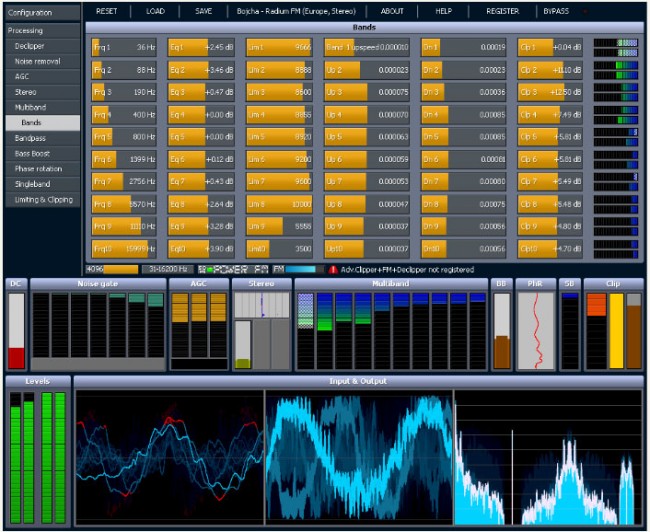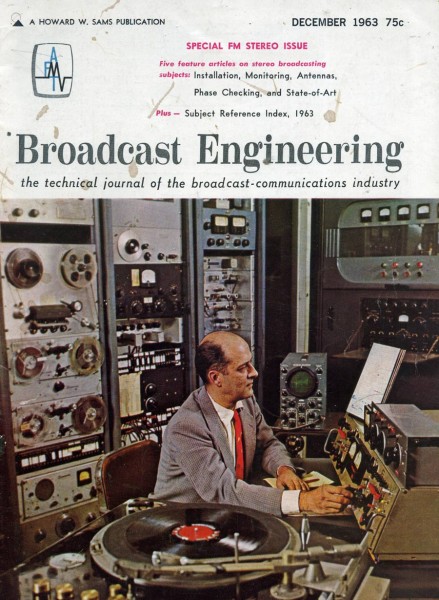This is a youtube video of a Police song from the 1980s received via skywave and recorded off-air on an AM radio.
Video Description:
The classic 1983 #1 smash hit, as received in analog C-Quam AM Stereo… in Japan… via nighttime skywave in the Tokyo area, roughly 500 miles away from Sapporo (ed: where the station is located). The audio quality is among the best I’ve ever heard from analog AM radio, thanks in large part to an excellent wideband receiver, very quiet band conditions, and the Orban Optimod-AM 9100 audio processor being used by HBC Radio to its maximum extent: 12.5 kHz audio bandwidth with stereo enhancement added (above and beyond the amount naturally provided by the matrix processing used by AM Stereo).
Absolute trash, I tell you. Just awful.
Of course, I know several FM stations around here that wished they sounded as good. Naturally, Japan, they have sought to minimize night-time interference problems by limiting the number of stations on the air and enforcing the rules and regulations in place to protect those stations on the air. They also seem to allow greater bandwidth, out to 12.5 KHz in spite of the narrower channel allocations (9 KHz in ITU regions I and III, vs 10 KHz here in the US, ITU region II). One other thing to note, there is no digital buzz saw occupying several channels of the broadcast spectrum. Keep in mind, this was received in Tokyo, likely a very high noise environment.
I was trying to find out the power level of the transmitter, the call sign is JOHR in Sapporo Japan, frequency is 1287 KHz. HBC is the Hokkaido Broadcasting Company, a privately held company. The state-run radio outlets in Japan are NHK, which has several radio and TV stations throughout the islands.
Anyway, AM is dead. Killed by the very owners of the broadcasting companies themselves with help from the NAB. They are the ones that petitioned the FCC to loosen up the allocations and allow more and more stations to be crammed into the band. That is old news. The new news is same forces that killed AM radio are diligently working their magic on the FM band as well. More stations, translators, digital IBOC nonsense that doesn’t work, more of everything. After all, more is better. Until it is not. Then it’s too late.






Paul, do you know when was this recorded? Is this station still on the air with this format in C-QUAM?
Lee, it was uploaded in 2009, but I don’t know when it was recorded. Wikipedia has them listed as C-QUAM. They are listed as 50 KW, Non-directional 124 meter tower at Asia radio stations: http://www.asiawaves.net/mediumwave-1278.htm
Seems like slightly more than 1/2 wave tower.
Their website doesn’t say anything about the AM radio station, although the google translator renders some if the titles and text a little funny.
I have to say this is quite impressive. I don’t recall hearing C-QUAM ever sounding this good here in the U.S. The closest thing I heard was when I was engineering the AM daytimer in Westport (former sister AM to what would become WEBE) which operated using the Kahn AM Stereo system with a STR-77 exciter. My first listen was on a Sony SRF-A1 walkman and and I was floored to hear how good it sounded.
Sadly, you are correct with the downfall of radio as we knew it. With the younger set finding alternatives I don’t expect to flourish anytime soon.
AM can sound good, it simply takes knowledgeable dedicated engineers with good ears. Much of the audio processing and the settings thereof can make a station sound like trash. When I started, we had a Gates “YARD” feeding a Gates “STA-LEVEL”, feeding a Gates SA-39 peak limiter with minimal compression. This was coupled to a Gates BC-1T with cathode-follower audio drivers feeding 833A triodes with about 14 dB of inverse feedback. It sounded real good. The loudness wars and the band-splitting processors started with Dorrough in the ’70’s, and some raved about the sound. I never liked this processor as the bias was unstable causing it to be a “DAP” (Distorted Audio Processor). I have seen some in stations with the covers removed so the operator could reset the bias to its correct value. I believe a good equalizer is all that is really needed to make up for the lost high-frequency response typical of AM receivers, especially automobile receivers. Some of the old stuff can be brought up to excellent audio standards through reconditioning, and if put on the air will rival much of the new “junque” out there on the air. The tube type GE BT-25A and some others were examples of true listenability; gone but not forgotten!
To me, the AM stereo non-decision was where the FCC really started to run off the rails in matters of technical regulation for radio broadcasting. The ‘marketplace’ wasn’t the proper authority to make that kind of choice, because the ‘marketplace’ is not a rational entity. Then there was HD, where the FCC’s technological train completely left the tracks and started bumping noisily along in the gravel of the roadbed with sparks flying everywhere. Now it seems that the Feds are virtually abandoning broadcast radio, now that it’s finally skidding into a jumbled pile of smoking wreckage. They’ve jumped straight onto the flying carpet of the internet and are zooming off into the ‘cloud’ without even a backwards glance. Try finding any mention of radio broadcasting on the new ‘re-imagined’ FCC.gov.
All they seem to care about anymore in broadcast radio is EEO and EAS or CAP or whatever it is now. Even so, it’s taken them 15 years to finally get around to scheduling an actual nationwide test of the EAS system. If EAS was so important, you would think that this first big test would have happened a lot sooner, like 1998.
When the big government FCC selected the Magnavox system of AM stereo in 1981 there was much dissension. President Reagan’s FCC Chairman at the time was a disk jockey as a kid and knew broadcasting. He was also a lawyer and knew that the FCC choice would lead to litigation from the other AM stereo players; Kahn, Motorola, Belar, and Harris, and that it would be in the courts for years. So he and the new FCC decided on the marketplace, along with the dumping of the previously proposed 9 kHz. channel mandate shuffle. Personally, I applauded this because it inspired robust competition without making U.S. AM stations have to change channels. If AM stereo was such a big deal (and I never thought that it was), the market reacted with C-QUAM as the defacto standard. Is the defacto standard always the best? Not necessarily, but at least there was a voting system of sorts rather than a government pick and mandate that everybody would be stuck with. It turned out that many broadcasters didn’t determine the winner, but the number of receivers with CQUAM chips did. Recently, the only HD format on domestic medium wave AM is a noisy spectrum polluter, and there wasn’t any choices put forth. We have basically gone in circles with technological trials and tribulations, and the original medium wave AM with standard 10 kHz. bandwidth has survived with many stations dumping the HD buzz saw. How long it will continue to be viable is any body’s guess.
I liked Bob Savage’s suggestion; have greater audio bandwidth daytime, then switch to a narrower audio bandwidth night time. No need for AM stereo or IBOC. The fact is the band is too crowded, too many stations shoe horned in, many antenna systems operating out of tolerance, etc.
There was a time when AM radio worked and worked well. Some people attribute that to lower noise levels, others to better receivers. I think it is an all of the above. It may require some tough love, like reducing the daytime and night time station counts to some level before this became a problem. The FCC does not have the wherewithal to do something like that.
Up to 15 kHz can be done on AM in the lower band, like LW and up to 1000kHz, daytime service 0600-1900.
Check out my youtube video of station JOUB 774Khz Akita Japan being received in Eureka, Ca. This is a super power 500KW AM station, one of many in Asia. As an AM DXer I really hate HD radio! I worked with the Kahn system back in the day and it was very high quality, and worked great at night under fading conditions.
http://www.youtube.com/watch?v=ie9cHNBKvpk
@ Lee Rust
I tend to agree that AM Stereo was where the commission went off the rail.
Trouble is, the initial choice by the commission was a total farce and hardly rational… to the point where I wonder to this day who got paid off.